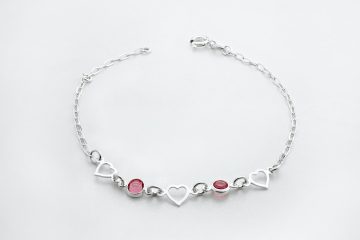Introduction
When it comes to selecting a bracelet, there are numerous factors to consider, including design, material, and price. However, one often overlooked aspect is the weight of the bracelet. The average bracelet weight can have a significant impact on the overall wearing experience and the durability of the piece. In this comprehensive analysis, we will delve into the importance of average bracelet weight, discussing its implications for comfort, aesthetics, and quality.
Why Does Bracelet Weight Matter?
Comfort and Wearability
The weight of a bracelet plays a crucial role in determining how comfortable it feels on the wrist. A bracelet that is too heavy may cause discomfort and strain, especially if worn for extended periods. On the other hand, a lightweight bracelet can go unnoticed and provide a more enjoyable wearing experience. The weight should be evenly distributed across the piece to avoid any pressure points that could lead to discomfort.
Moreover, the weight of a bracelet can impact its wearability. If a bracelet is too heavy, it may restrict movement and hinder daily activities. For instance, a heavy bracelet might make typing on a keyboard or performing delicate tasks more challenging. Therefore, it is essential to find a balance between weight and wearability to ensure the bracelet complements your lifestyle.
Aesthetics and Visual Appeal
The weight of a bracelet can also influence its aesthetic appeal. A heavier bracelet tends to exude a sense of luxury and sturdiness, while a lighter one may appear delicate and dainty. The weight can affect the way the bracelet drapes around the wrist, enhancing its visual impact and adding to its overall allure.
Furthermore, the weight can affect how the bracelet interacts with other pieces of jewelry. A heavier bracelet can anchor the look and serve as a statement piece, while a lightweight one can be layered or combined with other bracelets for a more delicate and intricate style. Thus, the weight of a bracelet contributes to the overall visual composition and helps achieve the desired aesthetic.
Durability and Quality
The weight of a bracelet is often indicative of its durability and quality. A heavier bracelet generally suggests the use of higher-quality materials, such as solid metals, which are more resistant to wear and tear. On the other hand, a lightweight bracelet might incorporate less robust materials or be hollow, making it more susceptible to damage.
While a heavy bracelet may be more durable, it is essential to consider the balance between weight and craftsmanship. A well-crafted bracelet should be sturdy regardless of its weight. It is crucial to assess the quality of the materials and construction to ensure the bracelet can withstand everyday use and maintain its beauty over time.
Factors Influencing Bracelet Weight
Material
The material used in the construction of a bracelet significantly impacts its weight. Different materials have varying densities, resulting in different overall weights. For example, a gold bracelet will generally be heavier than a silver one of the same size due to the difference in density between the two metals.
Other materials commonly used in bracelets, such as stainless steel, titanium, or leather, also have unique weight characteristics. Stainless steel tends to be heavier than titanium, while leather bracelets are typically lightweight. It is important to consider the weight implications when selecting a material that aligns with your preferences and lifestyle.
Design and Construction
The design and construction of a bracelet can influence its weight. Intricate and complex designs often involve more materials, adding to the overall weight. Bracelets with solid links or chains tend to be heavier than those with hollow links or more delicate structures.
Furthermore, the clasp or closure mechanism can contribute to the weight of the bracelet. A larger and more robust clasp may add additional weight, while a smaller and lightweight clasp can reduce the overall weight. The design choices made by the manufacturer can significantly impact the weight of the bracelet, so it is crucial to consider these factors when making a purchase.
Size and Thickness
The size and thickness of the bracelet also play a role in determining its weight. A larger bracelet will generally be heavier due to the increased amount of material used. Similarly, a thicker bracelet will have more density and weight compared to a thinner one.
When selecting a bracelet, it is important to consider your wrist size and personal preferences. A bracelet that is too large or thick may feel cumbersome and uncomfortable, while one that is too small or thin may lack the desired impact. Finding the right balance between size, thickness, and weight is key to achieving the perfect fit and aesthetic.
Conclusion
In conclusion, the average weight of a bracelet has significant implications for comfort, aesthetics, and quality. It directly affects the wearing experience, determining whether the bracelet feels cumbersome or goes unnoticed on the wrist. The weight also contributes to the overall visual appeal, adding to the bracelet’s allure and complementing other pieces of jewelry.
Furthermore, the weight of a bracelet often serves as an indicator of its durability and craftsmanship. While a heavier bracelet may suggest higher-quality materials and construction, it is essential to assess the balance between weight and durability. Considering factors such as material, design, and size can help you find the perfect bracelet that strikes the right balance between weight and wearability.
FAQs
1. Does a heavier bracelet always mean it is of higher quality?
Not necessarily. While a heavier bracelet can indicate the use of higher-quality materials, it is essential to consider the craftsmanship and construction. A well-crafted bracelet should be sturdy and durable, regardless of its weight. Assess the materials, design, and reputation of the manufacturer to determine the quality of the bracelet.
2. Are lightweight bracelets less durable than heavier ones?
Not necessarily. The weight of a bracelet is not the sole determinant of its durability. Lightweight bracelets can still be made with high-quality materials and be crafted to withstand everyday wear. It is important to consider the materials and construction to ensure the bracelet is durable and long-lasting.
3. Can a heavy bracelet be uncomfortable to wear?
Yes, a heavy bracelet can be uncomfortable to wear, especially if it is not properly balanced or if the weight is concentrated in one area. It is crucial to find a bracelet with even weight distribution to avoid discomfort and strain on the wrist.
4. Can the weight of a bracelet affect its price?
In some cases, the weight of a bracelet can impact its price. Bracelets made with heavier and more expensive materials, such as solid gold or platinum, will generally be priced higher than lighter alternatives. However, other factors such as design, brand, and craftsmanship also influence the price.
5. How can I determine the right weight for a bracelet?
The right weight for a bracelet depends on personal preference and comfort. It is recommended to try on different bracelets with varying weights to see which feels most comfortable and suits your lifestyle. Consider factors such as material, size, and design to find the perfect weight for your bracelet.




